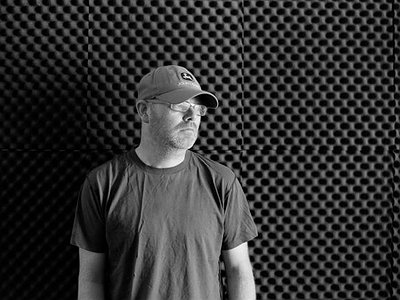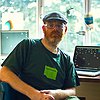When did you start writing/producing music - and what or who were your early passions and influences?
Around the age of 13 or 14 years old. My early influences included the Human League, Depeche Mode and Soft Cell. I was really drawn to synth pop in a big way. Although its emergence was clearly related to the earlier punk movement, I was just a little too young for punk rock; and at that time, I disliked the references to violence. Around this age I managed to get my first synthesizer and drum machine, and with some old cassette recorders began to make my first music. I kind of reverse engineered my musical influences and, as I learned more about electronic music began to discover earlier groups such as Throbbing Gristle. For me TG was the game changer. From that I progressed through On-U sound to early house and techno. I grew up in a particularly oppressive and challenging moment in British history. I witnessed first hand the devastating impact of the Thatcher government. I grew up next to Orgreave where the horrifying confrontation between the miners and the police took place. So for me at that early age, music articulated dissatisfaction with the world I had inherited and a resistance to it; but more importantly it offered alternatives.
What do you personally consider to be the incisive moments in your artistic work and/or career?
I think the first SND work with Mat Steel was pivotal. After struggling for a long time to make music I finally felt sort of happy with the first SND records. A fundamental breakthrough for me was the rejection of trying to instil excitement or energy in music and just to let it sit at one level and go on and on. Obviously there are many precursors to this in various musical genres. But in the context of my work, the integration of this approach was an important development. A second pivotal period was the release of Multistability and UL8. In the production of these works I was able to develop a number of techniques, for example algorithmic processes but also sound combinations. This extended the work I had been doing with SND.
What are currently your main compositional- and production-challenges?
The primary challenge right now is to combine ideas and approaches from what I refer to as "microtemporal" works, and to combine this with works that more clearly follow rhythmic structures found in house music. The way I tend to work is to establish two distinct approaches at the same time. For example with the early SND there was also the early Shirttrax work (with Jeremy Potter). These proposed very different approaches and styles. Currently I have two projects - the microtemporal series, and the "house" music series. So for me the challenge is working in these two ways and then seeing how they relate to one another.
What do you usually start with when working on a new piece?
A new piece is generally an extension of ideas from a previous piece. I never start "from scratch", and even if this was possible I would still not want to do it. I might have some ideas for how to develop certain aspects of a system I have been working with, or I might want to explore certain sound combinations.
How strictly do you separate improvising and composing?
Because I'm not from a musical background, I never studied music or learned to play a musical instrument, this kind of language just confuses me. A some level I know what improvisation is intended to mean, and I know what composing is intended to mean, but I prefer to describe my way of working in a much more day to day manner. The best analogy I can find is shed building. Here one might have a general plan, this may or may not be formalised, and the plan may or may not be revised in response to things that are encountered in the process of making the shed. For example when making a shed it is a good idea to decide where you want it to be before building it. And once that choice has been made it is difficult to change it later on. But, by contrast, some choices can be left open: for example one can decide on what colour to paint the shed once it is more or less built. Often when building a shed things do not go as expected and one has to think about how to solve specific problems. For example a gutter system to divert water into a water butt might not fit properly under the overhang of the roof, and so one has to think carefully about possible alternatives.
How do you see the relationship between sound, space and composition?
Sound and space are always related. When I think about space in this context I think about a few different things: the position of sound; the combination of sounds in different positions; the shape of the space within which sound happens; the materials used in the space within which the sound happens; the use of the space within which sound happens. Depending on the kind of work I am doing, I might consider these to a greater or lesser extent. For example if I am just doing a presentation of my work in front of an audience in a club, I just make a stereo work. Here, sound is not dynamically panned. But some elements are made up of statically panned elements. I do not apply artificial reverberation so that the actual properties of the space are more obvious. This means not putting too much activity in the sound. In installation contexts where I might have access to lots of speakers, I rend to place these in irregular formations and produce different tones in each one, so that it creates a sense of a single sound with a spatial element. For me there is a further consideration when working with the spatial element in sound. And that is to question ideas about how musical sounds function within other compositions. For example Dennis Smalley describes the use of spatial sound by referring heavily to natural landscapes with a number of different components, each of a different quality and activity. I personally try to confront this approach in the work I do by undermining any sense of landscape, foreground-background analysis.
Do you feel it important that an audience is able to deduct the processes and ideas behind a work purely on the basis of the music? If so, how do you make them transparent?
By processes do you mean: 1, how did I get to the venue; 2, how do I manipulate or not the attention of the audience; 3, what are the relationships between the various members of crew; 4, how a bit of software functions. I'm guessing 4. But why is this any more or less important than any of the others? I don't think there is such a thing as "purely on the basis of the music". Music cannot be meaningfully isolated from everything else. Or, if it is, then I think one gets a very shallow understanding of it.
Even if I try to answer your question "should the audience understand the technical process" then I still have to ask what is the technical process. Another thing is, what constitutes understanding in this context? For example if someone watches a violinist playing twinkle twinkle little star, one can "understand" that the movement of one thing against another creates a certain sound of a certain type. But how many audience members, from an observation of the music alone, would be able to deduce the physical behaviour of the string and a whole load of playing technique stuff. I think questions like "is it important that an audience is able to deduct the processes" are asked mainly when strings, reeds and skins are replaced with wire, dials and circuit boards. It's just how people go all weird once technologies of one kind or another are introduced.



